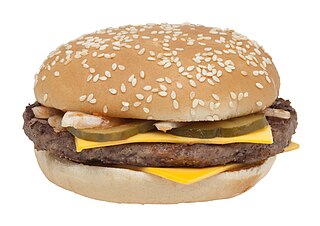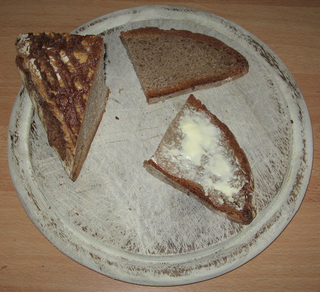Related Research Articles

A hamburger, or simply burger, is a food consisting of fillings—usually a patty of ground meat, typically beef—placed inside a sliced bun or bread roll. Hamburgers are often served with cheese, lettuce, tomato, onion, pickles, bacon, or chilis; condiments such as ketchup, mustard, mayonnaise, relish, or a "special sauce", often a variation of Thousand Island dressing; and are frequently placed on sesame seed buns. A hamburger patty topped with cheese is called a cheeseburger.

A sandwich is a food typically consisting of vegetables, sliced cheese or meat, placed on or between slices of bread, or more generally any dish wherein bread serves as a container or wrapper for another food type. The sandwich began as a portable, convenient finger food in the Western world, though over time it has become prevalent worldwide.

Hungarian or Magyar cuisine is the cuisine characteristic of the nation of Hungary, and its primary ethnic group, the Magyars. Hungarian cuisine has been described as being the spiciest cuisine in Europe. This can largely be attributed to the use of their piquant native spice, Hungarian paprika, in many of their dishes. A mild version of the spice, Hungarian sweet paprika, is commonly used as an alternative. Traditional Hungarian dishes are primarily based on meats, seasonal vegetables, fruits, bread, and dairy products.

Finnish cuisine is notable for generally combining traditional country fare and haute cuisine with contemporary continental-style cooking. Fish and meat play a prominent role in traditional Finnish dishes in some parts of the country, while the dishes elsewhere have traditionally included various vegetables and mushrooms. Evacuees from Karelia contributed to foods in other parts of Finland in the aftermath of the Continuation War.

A fried egg is a cooked dish made from one or more eggs which are removed from their shells and placed into a frying pan and fried. They are traditionally eaten for breakfast in many countries but may also be served at other times of the day.

The Reuben sandwich is a North American grilled sandwich composed of corned beef, Swiss cheese, sauerkraut, and Russian dressing or Thousand Island dressing, grilled between slices of rye bread. It is associated with kosher-style delicatessens but is not kosher, as it combines meat and cheese.

An open sandwich, also known as an open-face/open-faced sandwich, bread baser, bread platter or tartine, consists of a slice of bread or toast with one or more food items on top. It has half the amount of bread of a typical closed sandwich.

Liverwurst, leberwurst, or liver sausage is a kind of sausage made from liver. It is eaten throughout Europe, as well as North and South America, notably in Argentina and Chile.

Danish cuisine originated from the peasant population's own local produce and was enhanced by cooking techniques developed in the late 19th century and the wider availability of goods during and after the Industrial Revolution. Open sandwiches, known as smørrebrød, which in their basic form are the usual fare for lunch, can be considered a national speciality when prepared and garnished with a variety of ingredients. Hot meals are typically prepared with meat or fish. Substantial meat and fish dishes includes flæskesteg and kogt torsk with mustard sauce and trimmings. Ground meats became widespread during the industrial revolution and traditional dishes that are still popular include frikadeller, karbonader and medisterpølse. Denmark is known for its Carlsberg and Tuborg beers and for its akvavit and bitters, but amongst the Danes themselves imported wine has gained steadily in popularity since the 1960s.

Dutch cuisine is formed from the cooking traditions and practices of the Netherlands. The country's cuisine is shaped by its location in the fertile North Sea river delta of the European Plain, giving rise to fishing, farming and overseas trade. The Burgundian-Habsburg court enriched the cuisine of the Dutch elite in the 15th and 16th century, so did the colonial spice trade in the 17th century.

A schnitzel is a thin slice of meat. The meat is usually thinned by pounding with a meat tenderizer. Most commonly, the meat is breaded before frying. Breaded schnitzel is popular in many countries and is made using veal, pork, chicken, mutton, beef, or turkey. Schnitzel is very similar to the dish escalope in France and Spain, panado in Portugal, tonkatsu in Japan, cotoletta in Italy, kotlet schabowy in Poland, milanesa in Latin America, chuleta valluna in Colombia, chicken chop in Malaysia, and chicken-fried steak and pork tenderloin of the United States.

Smørrebrød, smørbrød "butter bread" (Norwegian), or smörgås "butter goose" (Swedish), is a traditional open-faced sandwich in the cuisines of Denmark, Norway and Sweden that usually consists of a piece of buttered rye bread, topped with commercial or homemade cold cuts, pieces of meat or fish, cheese or spreads, and garnishes.
Norwegian cuisine in its traditional form is based largely on the raw materials readily available in Norway and its mountains, wilderness, and coast. It differs in many respects from continental cuisine through the stronger focus on game and fish. Many of the traditional dishes are the result of using conserved materials, necessary because of the long winters.

In German cuisine, Butterbrot is a slice of bread topped with butter. It is still considered Butterbrot even if additional toppings such as cheese, spreads, or lunch meats are added, as long as it begins with a slice of bread with butter.

Strammer Max is a traditional name applied to various sandwich dishes in German cuisine.

Choripán is a type of sandwich with chorizo popular in Argentina, Chile, Uruguay, Paraguay, Peru, Bolivia and Venezuela. The name comes from the combination of the names of its ingredients: a grilled chorizo sausage and a crusty bread such as a pan batido, baguette, or francés.

A breakfast sandwich is any sandwich filled with foods associated with breakfast. Breakfast sandwiches are served at fast food restaurants and delicatessens, sold in supermarkets, or commonly made at home. Different types of breakfast sandwich include the bacon sandwich, the egg sandwich, and the sausage sandwich; or various combinations thereof, like the bacon, egg and cheese sandwich. The breakfast sandwich is related to the breakfast roll.
Traditional Estonian cuisine has substantially been based on meat and potatoes, and on fish in coastal and lakeside areas, but now bears influence from many other cuisines, including a variety of international foods and dishes, with a number of contributions from the traditions of nearby countries. Scandinavian, German, Russian, Latvian, Lithuanian and other influences have played their part. The most typical foods in Estonia have been rye bread, pork, potatoes and dairy products. Estonian eating habits have historically been closely linked to the seasons. In terms of staples, Estonia belongs firmly to the beer, vodka, rye bread and pork "belt" of Europe.

Smörgåsbord is a buffet-style meal of Swedish origin. It is served with various hot and cold dishes.

Limburger is a cheese that originated in the Herve area of the historical Duchy of Limburg, which had its capital in Limbourg-sur-Vesdre, now in the French-speaking Belgian province of Liège. The cheese is especially known for its strong smell caused by the bacterium Brevibacterium linens.
References
- ↑ "Definition of DUTCH LUNCH". www.merriam-webster.com. Retrieved 2023-09-17.
- ↑ Chambers's Journal of Popular Literature, Science and Arts. Orr and Smith. 1851.
- ↑ Humanities, National Endowment for the (1872-01-30). "Wilmington daily commercial. [volume] (Wilmington, Del.) 1866-1877, January 30, 1872, Image 1". ISSN 2574-6685 . Retrieved 2023-10-17.
- ↑ The Scroll of Phi Delta Theta. Phi Delta Theta Fraternity. 1880.
- ↑ Denver Medical Times: Utah Medical Journal. Nevada Medicine. s.l. 1896.
- ↑ The Bay View Magazine. J. M. Hall. 1897.
- 1 2 The Paper Box Maker and American Bookbinder. Vol. II. 1898. p. 4.
- ↑ Whist. Whist Publishing Company. 1899.
- ↑ Gibbard, Philip (May 1990). "N. R. Gadd (ed.) 1988. The Late Quaternary Development of the Champlain Sea Basin. Geological Association of Canada, Special Paper 35. Proceedings of a symposium held in Ottawa, 21 May 1986. vii + 312 pp. May be ordered from: GAC Publications, Department of Earth Sciences, Memorial University of Newfoundland, St John's, Newfoundland, Canada A1B 3X5. Price C$50 (members), C$60 (non-members); postage and handling C$3.50 in Canada, C$5 foreign; hard covers. ISBN 0 919216 35 8". Geological Magazine. 127 (3): 286–287. doi:10.1017/s0016756800014710. ISSN 0016-7568.
- ↑ Borzo, Greg (2019-04-22). Lost Restaurant of Chicago. Arcadia Publishing. ISBN 978-1-4396-6592-3.
- ↑ Chidlow, David (1899). The American Pure Food Cook Book and Household Economist. Geo. M. Hill Company.
- 1 2 Goins, John B. (1914). The American Waiter: Instructions in American and European Plan Service, Banquet and Private Party Work. Hotel Monthly Press.
- 1 2 Fernandez, Aleida. "Tommy's Dutch Lunch: Never Leave Hungry". Whitman Wire. Retrieved 2023-10-17.
- ↑ Drazan, Joe (2019-01-30). "Bygone Walla Walla: vintage images of the City and County (and beyond), collected by Joe Drazan: Tommy's Dutch Lunch opened about 1933 in what was Walter Fansher's Service Station at 1203 West Pine". Bygone Walla Walla. Retrieved 2023-10-17.
- ↑ "Tommy's Dutch Lunch". Visit Walla Walla. Retrieved 2023-10-17.
- ↑ "Dutch Lunch advertisement" (PDF). 1936. Archived from the original (PDF) on 2021-11-05. Retrieved 2023-10-17.
- ↑ "Pool's Sandwiches, 6290 Sunset Blvd, southeast corner of Vine St, Hollywood, circa late 1930s |". 2018-01-21. Retrieved 2023-10-17.
- ↑ "22. Fake News: Civil War Version – Tales from the Vault: 40 Years / 40 Stories" . Retrieved 2023-09-17.
- ↑ Magee, John L. (1865). "Jeff. Davis caught at last. Hoop skirts & Southern chivalry". library.osu.edu. Retrieved 2023-09-17.